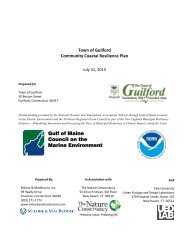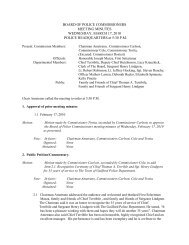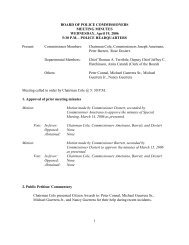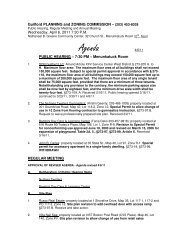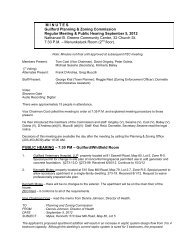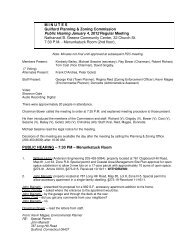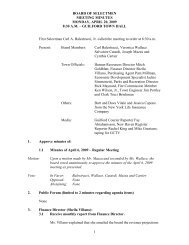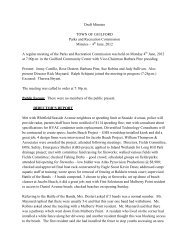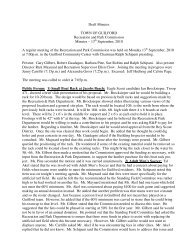Natural Resource Inventory and Assessment - Town of Guilford
Natural Resource Inventory and Assessment - Town of Guilford
Natural Resource Inventory and Assessment - Town of Guilford
Create successful ePaper yourself
Turn your PDF publications into a flip-book with our unique Google optimized e-Paper software.
Coast<br />
B2<br />
coves <strong>and</strong> inlets. The dominant feature <strong>of</strong> the <strong>Guilford</strong> shoreline is its rocky shorefront; tidal wetl<strong>and</strong>s exist<br />
along 17 percent <strong>of</strong> the shoreline. <strong>Guilford</strong>’s coastal area includes Faulkner’s Isl<strong>and</strong> <strong>and</strong> coastal waters to the<br />
mid-point <strong>of</strong> Long Isl<strong>and</strong> Sound.<br />
Eight rivers, including the East <strong>and</strong> West Rivers <strong>and</strong> Sluice Creek, flow from <strong>Guilford</strong> into Long Isl<strong>and</strong><br />
Sound. Hoadley Creek drains <strong>Town</strong>er Swamp, a large freshwater wetl<strong>and</strong> near the Branford <strong>Town</strong> line.<br />
Details <strong>of</strong> the numerous creeks, coves, bays, marshes, <strong>and</strong> river estuaries which constitute <strong>Guilford</strong>’s coastline<br />
can be seen on Map B-1 <strong>and</strong> B-2. Tides influence the lower two miles <strong>of</strong> <strong>Guilford</strong>’s West River <strong>and</strong> the lower 3<br />
to 4 miles <strong>of</strong> the East River. Saltwater tidal marshes <strong>and</strong> mud flats occur not only on <strong>Guilford</strong>’s shorefront,<br />
they also extend up the West <strong>and</strong> East Rivers until salt water is diluted by fresh water from upstream.<br />
Approximately 80 percent <strong>of</strong> <strong>Guilford</strong>’s coastline is in residential ownership. Public owners on the<br />
shoreline include Connecticut DEP (294 acres), <strong>and</strong> the <strong>Town</strong> <strong>of</strong> <strong>Guilford</strong> (94 acres); <strong>Guilford</strong> L<strong>and</strong><br />
Conservation Trust <strong>and</strong> National Audubon each own several small parcels. Beach frontage is primarily<br />
privately owned <strong>and</strong> there are more than ten private beach associations. Jacob’s Beach is the only public<br />
beach, aside from a half-acre beach at Shell Beach on Leete’s Isl<strong>and</strong>. (See Appendix B Coastal Data.)<br />
According to the 2000 Census, more than 16 percent <strong>of</strong> <strong>Guilford</strong>’s population (3,297 residents) live in<br />
the quadrangle between the East <strong>and</strong> West Rivers, I-95 <strong>and</strong> the coast. This area represents less than 3<br />
percent (approximately 700 acres) <strong>of</strong> <strong>Guilford</strong>’s total l<strong>and</strong> area. Within the Coastal Management Area are four<br />
commercial <strong>and</strong> industrial areas: Boston Post Road East (includes Shoreline Plaza), the shopping area near the<br />
<strong>Town</strong> Green, Lower Whitfield Street (includes the area around the train station <strong>and</strong> the <strong>Town</strong> Marina), <strong>and</strong> the<br />
quadrant north <strong>of</strong> Amtrak bounded by Soundview Road, Route One, <strong>and</strong> South Union Street.<br />
B.4 Importance<br />
The natural resources <strong>of</strong> <strong>Guilford</strong>’s coastal area are important for many reasons.<br />
Food source. At the center <strong>of</strong> the food web that includes lobsters, clams, <strong>and</strong> oysters are one-celled<br />
plants called phytoplankton. These plants depend on a complex dynamic among mud, silt, tides, wind,<br />
currents, <strong>and</strong> sun. Eaten by animals such as mussels, snails, crabs, <strong>and</strong> minnows (which are themselves<br />
subsequently eaten by fish), phytoplankton could be considered the single most important element <strong>of</strong> any<br />
coastal system. Most <strong>of</strong> the fish that we eat start their lives in tidal wetl<strong>and</strong>s. Tidal wetl<strong>and</strong>s are one <strong>of</strong> the<br />
most biologically productive natural systems known, second only to rain forests. As twice-daily tides carry<br />
nutrients back <strong>and</strong> forth between the marshes <strong>and</strong> Long Isl<strong>and</strong> Sound, they also carry fresh water from<br />
upl<strong>and</strong> areas <strong>and</strong> rivers into the Sound.<br />
Wildlife habitat. Because <strong>of</strong> its abundant food supply, <strong>Guilford</strong>’s coastal system serves as an important<br />
food source, breeding ground, nursery for raising young, <strong>and</strong> resting stop for thous<strong>and</strong>s <strong>of</strong> migratory birds<br />
along the Atlantic Flyway, a major eastern migration route also used by monarch butterflies.<br />
Ecosystem services. Through filtration, tidal wetl<strong>and</strong>s improve water quality by reducing turbidity <strong>and</strong><br />
restricting the passage <strong>of</strong> toxins. Tidal wetl<strong>and</strong> vegetation stabilizes the shoreline <strong>and</strong> buffers erosion. Because<br />
<strong>of</strong> their capacity to absorb water, tidal marshes protect human property by dissipating waves during storms.<br />
Bivalves such as hard <strong>and</strong> s<strong>of</strong>tshelled clams also provide a cleansing effect by virtue <strong>of</strong> their filter feeding habit.<br />
Commercial fishing. Historically, the coastal marshes <strong>and</strong> the Sound were primary sources <strong>of</strong> food for<br />
Native Americans <strong>and</strong> Europeans who settled in <strong>Guilford</strong>. Today lobsters, shellfish, blue <strong>and</strong> black fish provide<br />
activity for commercial fishermen in <strong>Guilford</strong>. The <strong>Guilford</strong> Shellfish Commission (GSC) issues annual leases<br />
for commercial fishing from clam <strong>and</strong> oyster beds <strong>of</strong>f the coast <strong>and</strong> in the East <strong>and</strong> West Rivers. Shellfish from<br />
restricted areas are also trucked into Isl<strong>and</strong> Creek by commercial fishermen for a six-to-eight-week period <strong>of</strong><br />
“cleansing” before being removed <strong>and</strong> relocated for harvesting from other locations. Oyster beds are managed<br />
by the Shellfish Commission on the East River <strong>and</strong> the West River. At another boatyard on the West River,<br />
<strong>Natural</strong> <strong>Resource</strong> <strong>Inventory</strong> <strong>and</strong> <strong>Assessment</strong> <strong>Town</strong> <strong>of</strong> <strong>Guilford</strong>, CT



